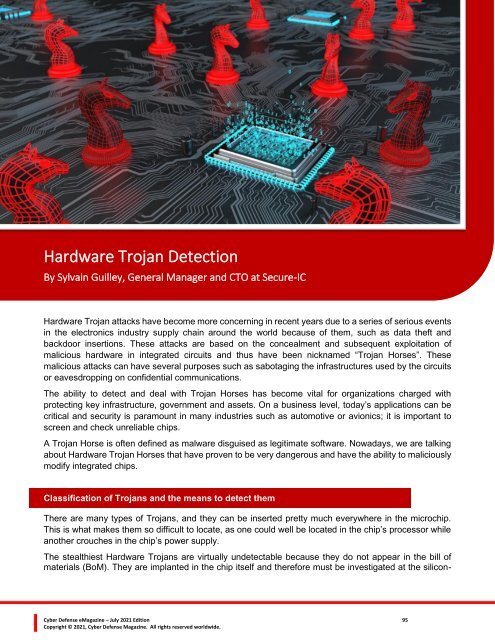Cyber Defense eMagazine July 2021 Edition
Cyber Defense eMagazine July Edition for 2021 #CDM #CYBERDEFENSEMAG @CyberDefenseMag by @Miliefsky a world-renowned cyber security expert and the Publisher of Cyber Defense Magazine as part of the Cyber Defense Media Group as well as Yan Ross, US Editor-in-Chief, Pieruligi Paganini, Co-founder & International Editor-in-Chief, Stevin Miliefsky, President and many more writers, partners and supporters who make this an awesome publication! Thank you all and to our readers! OSINT ROCKS! #CDM #CDMG #OSINT #CYBERSECURITY #INFOSEC #BEST #PRACTICES #TIPS #TECHNIQUES
Cyber Defense eMagazine July Edition for 2021 #CDM #CYBERDEFENSEMAG @CyberDefenseMag by @Miliefsky a world-renowned cyber security expert and the Publisher of Cyber Defense Magazine as part of the Cyber Defense Media Group as well as Yan Ross, US Editor-in-Chief, Pieruligi Paganini, Co-founder & International Editor-in-Chief, Stevin Miliefsky, President and many more writers, partners and supporters who make this an awesome publication! Thank you all and to our readers! OSINT ROCKS! #CDM #CDMG #OSINT #CYBERSECURITY #INFOSEC #BEST #PRACTICES #TIPS #TECHNIQUES
Create successful ePaper yourself
Turn your PDF publications into a flip-book with our unique Google optimized e-Paper software.
Hardware Trojan Detection<br />
By Sylvain Guilley, General Manager and CTO at Secure-IC<br />
Hardware Trojan attacks have become more concerning in recent years due to a series of serious events<br />
in the electronics industry supply chain around the world because of them, such as data theft and<br />
backdoor insertions. These attacks are based on the concealment and subsequent exploitation of<br />
malicious hardware in integrated circuits and thus have been nicknamed “Trojan Horses”. These<br />
malicious attacks can have several purposes such as sabotaging the infrastructures used by the circuits<br />
or eavesdropping on confidential communications.<br />
The ability to detect and deal with Trojan Horses has become vital for organizations charged with<br />
protecting key infrastructure, government and assets. On a business level, today’s applications can be<br />
critical and security is paramount in many industries such as automotive or avionics; it is important to<br />
screen and check unreliable chips.<br />
A Trojan Horse is often defined as malware disguised as legitimate software. Nowadays, we are talking<br />
about Hardware Trojan Horses that have proven to be very dangerous and have the ability to maliciously<br />
modify integrated chips.<br />
Classification of Trojans and the means to detect them<br />
There are many types of Trojans, and they can be inserted pretty much everywhere in the microchip.<br />
This is what makes them so difficult to locate, as one could well be located in the chip’s processor while<br />
another crouches in the chip’s power supply.<br />
The stealthiest Hardware Trojans are virtually undetectable because they do not appear in the bill of<br />
materials (BoM). They are implanted in the chip itself and therefore must be investigated at the silicon-<br />
<strong>Cyber</strong> <strong>Defense</strong> <strong>eMagazine</strong> – <strong>July</strong> <strong>2021</strong> <strong>Edition</strong> 95<br />
Copyright © <strong>2021</strong>, <strong>Cyber</strong> <strong>Defense</strong> Magazine. All rights reserved worldwide.


















